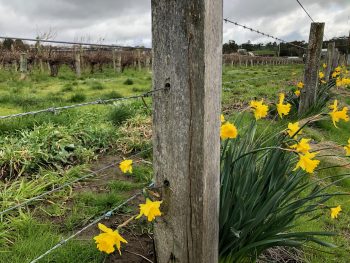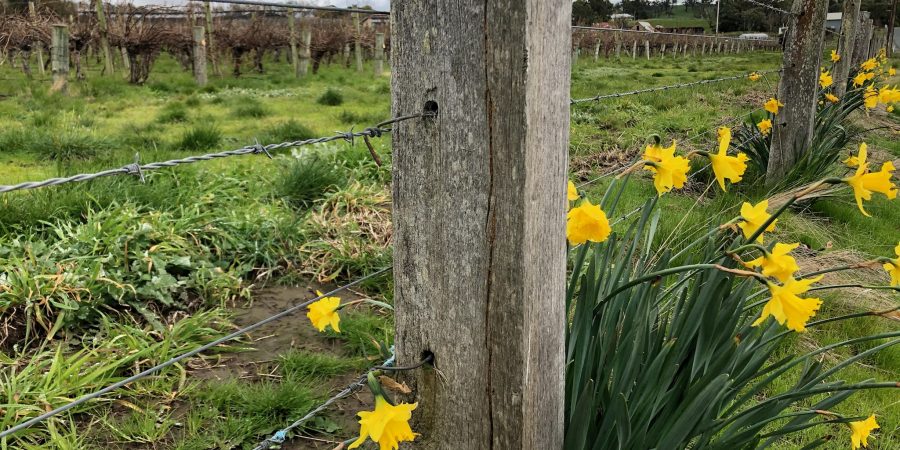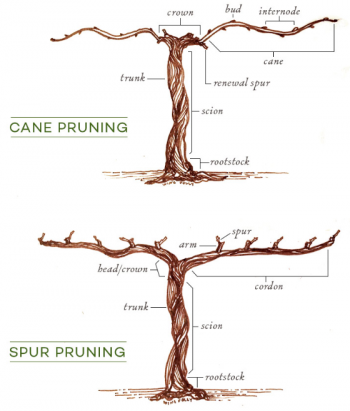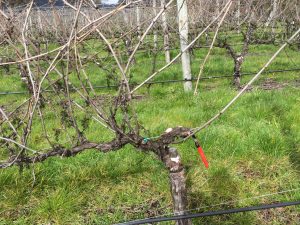 As all you avid gardeners out there know, the time to prune is well and truly upon us. Or passed, considering the beautiful weather we’ve been having this week.
As all you avid gardeners out there know, the time to prune is well and truly upon us. Or passed, considering the beautiful weather we’ve been having this week.
When it comes to grapevines, some growers like to get in early (and get it over and done with!) while others like to wait as long as possible.
You see, the idea is, the later you prune the later budburst will occur. In cool climates (like the Hills) this could mean missing an early frost.
As a matter of fact, Kim Anderson at Charleston pruned his Sauvignon Blanc (which becomes our Sauvignon Blanc) just last week. You can see them in the background of this photo he sent me of his daffodils!
Whatever the timing, grapevine pruning has to be one of the most complicated processes I’ve ever had to get my head around. And I’m still not sure I understand!
So, let’s revisit a post I wrote in 2019, to which I’ll add some extra info I gleaned from a brief lunchtime discussion with my resident viticulturist (my husband) yesterday…
There are two main ways to prune grapevines:
Cane versus spur pruning
Cane pruning is commonly used in cooler climate growing regions. By limiting the vine’s lignified growth (the hard brown part) to just the trunk, the vine is less vulnerable to frost and better protected than spur-pruned vines. Cane pruning takes great skill to do well because it requires manually cutting back nearly all the vine’s prior growth and correctly selecting a single cane (or two) that will be responsible for next season’s production. It has been adopted by many of the world’s most prestigious wine-growing areas.
Spur pruning is common in warmer climate growing regions. Spur pruning is done on vines that retain one or two pairs of long canes (a permanent cordon) trained along a trellis system. Each winter, new canes that have grown along the permanent cordon are cut back to a small shoot containing two buds, known as a spur. In spring new growth develops from the buds on the spur. Spur pruning is a more traditional training method that is known to produce outstanding old vine wines.
Why cane prune?
Cane pruning is very time-consuming and expensive, so why do it?
There are a couple of really good reasons…
What about machine pruning?
Yes, grapevines can be pruned mechanically. It’s much quicker and easier and can significantly cut the costs associated with pruning. However, it also means less control over the process. Less control over the final yield and quality of the fruit. The costs should be weighed up against the benefits when making a decision about pruning by machine.
Often growers will do the first trim (called the pre-prune) with a machine. Then come in with the hired help to do the final prune.
How to decide
The type and timing of pruning are dependant upon a number of different variables. These include…
Variety: each variety of grapevine produces fruit in its own particular way. Sauvignon Blanc, for example, produces fruit towards the end of their canes. So, cane pruning is the obvious choice here.
Age: in young vines (2-3 years old) pruning serves to build the long-term structure of the plant. For older vines, pruning helps to manage the shape and crop load for the upcoming vintage.
Vigour: Some varieties (like Shiraz and Pinot Noir) are more vigorous (or grower quicker and bigger) and produce more shoots than others. Pruning helps to minimise the number of shoots so the canopy doesn’t become too dense.
Sometimes in vigorous varieties, a “sacrificial”(or “kicker”) cane is left long (and not pruned). This takes energy and growth out of the rest of the vine and prevents it from over-producing.
End product: Pruning can have a big impact on the quality of grapes the vine produces at the end of the growing season. If you’re looking to make a high-end wine, pruning is an important part of the process.
For the lower end of the value spectrum, machine pruning will do the trick nicely. But don’t get me wrong, not all machine pruned vines are destined to produce “cheap” wines!
Pruning – fun facts!
- Vines should only be pruned when they are dormant – it just needs to happen before the sap starts rising in Spring
- Pruning can influence the quantity (and quality) of the fruit produced
- Without pruning, grapevines can grow to enormous proportions – up to 35 meters long!
- Pruning can be used to manage the position of fruit in relation to the sun. In some vineyard rows, the north and south-facing sides are pruned differently.
- The cost of pruning contributes 30-40% of the total cost of growing grapevines.
- A clean cut is important – less stress is placed on the plant and exposes less surface area to the elements
- Pruning is a vital part of the health of the vine and the quality of the fruit and the end product!


